Are you a Quiet Speculation member?
If not, now is a perfect time to join up! Our powerful tools, breaking-news analysis, and exclusive Discord channel will make sure you stay up to date and ahead of the curve.
Eldritch Moon spoilers are finally underway, and living up to my high expectations. Fan-favorite flavor? Check. More Eldrazi? Check. (I may be the only person celebrating this one.) What about playable delirium cards? You bet! My favorite of the bunch, Gnarlwood Dryad, joins Wild Nacatl, Nimble Mongoose, and Delver of Secrets himself as a one-mana, three-power beater with his own deckbuilding restriction. Luckily for me, it's one I'm already building around.
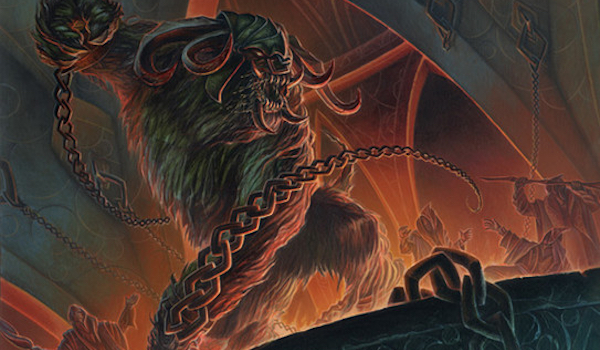
Every batch of spoilers gives me new decks to build. I'm even building the bad ones. Like, Colfenor's Plans into [tippy title="Harmless Offering" width="330" height="330"]
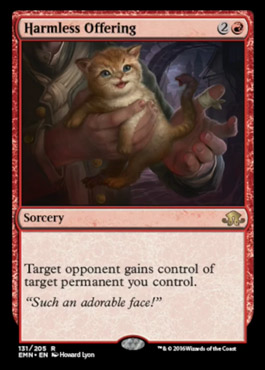
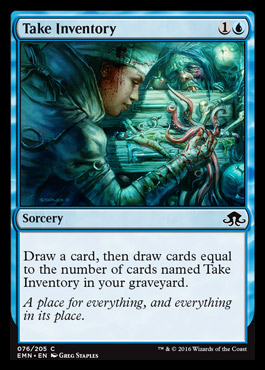
[/tippy] bad. My most recent pile uses [tippy title="Eldritch Evolution" width="330" height="330"]
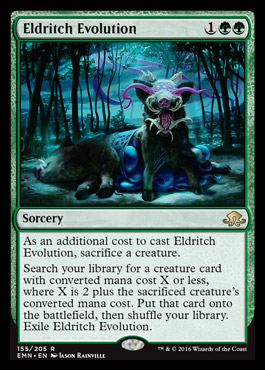

[/tippy] to turn Allosaurus Rider into Griselbrand or Iona, Shield of Emeria on turn two. But the brew that's tested best for me so far fits [tippy title="Gnarlwood Dryad" width="330" height="330"]
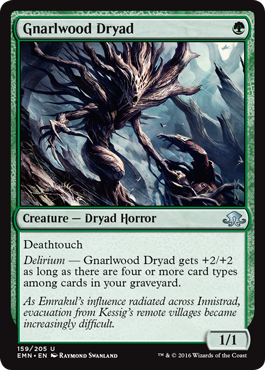 [/tippy] into a hyper-aggressive one-drop Zoo shell with a respectable mid-game.
[/tippy] into a hyper-aggressive one-drop Zoo shell with a respectable mid-game.
[wp_ad_camp_1]
Why Zoo?
Before settling on Zoo I tested [tippy title="Gnarlwood Dryad" width="330" height="330"]
 [/tippy] in a few different shells, but ran into problems with each other deck.
[/tippy] in a few different shells, but ran into problems with each other deck.
 Monkey Grow: There was a time when I would have loved a Nimble Mongoose printing for Modern, which is why the Hooting Mandrills spoiler made me so excited. Those days are far behind us, and Mandrills has stood the test of time. I still had to at least try Gnarlwood in a Delver shell. Essentially, Gnarlwood slotted into Temur Delver as a means to play Counter-Cat without splashing white. I ran a set of Mishra's Bauble, two copies of Tarfire, and the obvious Serums and Probes to make it work. The major upside of this idea was the ability to run Blood Moon in the sideboard and not fall prey to it ourselves.
Monkey Grow: There was a time when I would have loved a Nimble Mongoose printing for Modern, which is why the Hooting Mandrills spoiler made me so excited. Those days are far behind us, and Mandrills has stood the test of time. I still had to at least try Gnarlwood in a Delver shell. Essentially, Gnarlwood slotted into Temur Delver as a means to play Counter-Cat without splashing white. I ran a set of Mishra's Bauble, two copies of Tarfire, and the obvious Serums and Probes to make it work. The major upside of this idea was the ability to run Blood Moon in the sideboard and not fall prey to it ourselves.
But delirium sometimes proved difficult to turn on when we wanted fast pressure to compliment our Spell Pierces. Maxing out on Mandrills seems like a superior plan to me in these colors, since it means our threats all die in different ways; running Gnarlwood gives opponents another great use for Lightning Bolt. Losing Disrupting Shoal to make space for delirium enablers also hurt the deck significantly compared with traditional Monkey Grow. Finally, compared with Counter-Cat, having Path to Exile really makes small ground creatures much stronger. Deathtouch isn't quite evasion, and many opponents will be happy to trade Kitchen Finks for the ambitious newcomer if it means clearing the way for Sun Titan or Tarmogoyf.
Temur Traverse: Space is already very tight in Lili Traverse, my current go-to build of Temur Traverse. I redesigned the deck to include [tippy title="Gnarlwood Dryad" width="330" height="330"]
 [/tippy] by focusing more heavily on delirium than on disruption. This approach allowed me to try out a few other cards from Eldritch Moon, too. I played full sets of Scour, Bauble, Tarmogoyf, and Snapcaster Mage, as well as a few copies of [tippy title="Curious Homunculus" width="660" height="330"]
[/tippy] by focusing more heavily on delirium than on disruption. This approach allowed me to try out a few other cards from Eldritch Moon, too. I played full sets of Scour, Bauble, Tarmogoyf, and Snapcaster Mage, as well as a few copies of [tippy title="Curious Homunculus" width="660" height="330"]

[/tippy]. I liked the Homunculus as an extra beater 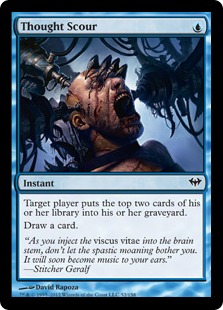 that can run over opponents with prowess (growing past Awoken Horror on the crucial attacking turn), and his Goblin Electromancer ability played very well with another card I included in fours: [tippy title="Take Inventory" width="330" height="330"]
that can run over opponents with prowess (growing past Awoken Horror on the crucial attacking turn), and his Goblin Electromancer ability played very well with another card I included in fours: [tippy title="Take Inventory" width="330" height="330"]
 [/tippy]. I'd assume [tippy title="Take Inventory" width="330" height="330"]
[/tippy]. I'd assume [tippy title="Take Inventory" width="330" height="330"]
 [/tippy] would usually clash with Ancestral Vision in many deckbuilding scenarios, but I will say the sorcery-speed Accumulated Knowledge surpassed my expectations in testing.
[/tippy] would usually clash with Ancestral Vision in many deckbuilding scenarios, but I will say the sorcery-speed Accumulated Knowledge surpassed my expectations in testing.
The problem with this build was that Temur Traverse just doesn't really want a Wild Nacatl. It helps that Gnarlwood has deathtouch, but I often found myself hoping he'd eat a Lightning Bolt so I could stick and transform my homunculus on the next turn. That probably means two things: first, Gnarlwood doesn't bring much to Temur Traverse decks. Second, [tippy title="Curious Homunculus" width="660" height="330"]

[/tippy] doesn't resist the Bolt Test fast enough to see Modern play. If it transformed on our end step, we might have something special.
*A quick note on Lili Traverse: for now, Emrakul has been relegated to the sideboard. I still like the rest of the main.
The Zoo-lution
Anyone who's played Zoo in Modern can tell you the deck's superb draws feature three one-drops. Experiment One into Goblin Guide, Wild Nacatl wins plenty of games, as the creatures overload an opponent's efficient removal and can easily take them to zero in a couple turns. The draws where a turn one Nacatl gets Bolted and the Zoo pilot struggles to get over their opponent's shiny new Tarmogoyf are significantly less attractive. Gnarlwood helps the deck on both counts, increasing its efficient one-drop density (let's be real, Kird Ape sucks) and serving as a creature Tarmogoyf and other valuable fatties hate blocking.
Introducing Delirium Zoo
Like Wild Nacatl and Delver of Secrets, [tippy title="Gnarlwood Dryad" width="330" height="330"]
 [/tippy] rewards players with a 3/3 for one mana if they can meet specific deckbuilding conditions. Luckily for brewers, delirium is easier to turn on than some would have you believe, and it importantly does little to clash with some other deckbuilding constraints. One of these is the manabase---we can easily tune a deck to put four card types in the graveyard as it assembles Forest, Plains, and Mountain, meaning Gnarlwood and Nacatl don't cannibalize each other's deckbuilding space.
[/tippy] rewards players with a 3/3 for one mana if they can meet specific deckbuilding conditions. Luckily for brewers, delirium is easier to turn on than some would have you believe, and it importantly does little to clash with some other deckbuilding constraints. One of these is the manabase---we can easily tune a deck to put four card types in the graveyard as it assembles Forest, Plains, and Mountain, meaning Gnarlwood and Nacatl don't cannibalize each other's deckbuilding space.
That said, Gnarlwood rewards players for running noncreature cards, and a Gnarlwood-Nacatl strategy promises to load up on creatures. One way around this is to play cantrips with rare card types and creatures with additional card types. After a day of tweaking, here's what I ended up with:
Delirium Zoo, by Jordan Boisvert
Just as building around Delver of Secrets gives players access to great Snapcaster Mages, building around [tippy title="Gnarlwood Dryad" width="330" height="330"]
 [/tippy] also carries significant benefits. We already enjoy stocking the graveyard thanks to Tarmogoyf. And aiming for early delirium further incentivizes us to play Traverse the Ulvenwald. Our ability to dig 7/8 Tarmogoyfs out of the deck after resource exchanges gives us a stronger mid-game against interactive strategies, and Traverse enables a flexible creature toolbox from the sideboard, allowing us to ditch some aggressive elements for a better-rounded Game 2.
[/tippy] also carries significant benefits. We already enjoy stocking the graveyard thanks to Tarmogoyf. And aiming for early delirium further incentivizes us to play Traverse the Ulvenwald. Our ability to dig 7/8 Tarmogoyfs out of the deck after resource exchanges gives us a stronger mid-game against interactive strategies, and Traverse enables a flexible creature toolbox from the sideboard, allowing us to ditch some aggressive elements for a better-rounded Game 2.
Achieving Delirium
Delirium might arrive naturally in most games, but turning it on faster yields ideal results. Without sorceries other than Traverse the Ulvenwald, Mishra's Bauble and Tarfire play important roles in setting up the graveyard. We could maybe avoid playing Bauble if we added more sorceries, but I don't like our other sorcery options; Flame Slash doesn't go to the face, and I'd rather it be a creature anyway. Gitaxian Probe is too taxing without blue mana, and considering we run Eidolon.
General Gameplan
In Game 1, Delirium Zoo is generally the aggressor. Many decks struggle against highly aggressive Zoo decks pre-board, and we aim to capitalize on that advantage. 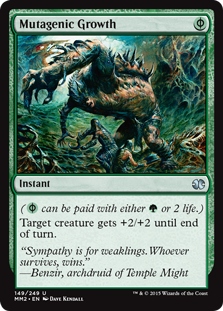 Mutagenic Growth helps us push our creatures past enemy fatties and Lightning Bolts, and Traverse the Ulvenwald usually ends the game by searching up the lone Ghor-Clan Rampager for an alpha strike. (Side note: Ghor-Clan has sweet synergy with [tippy title="Gnarlwood Dryad" width="330" height="330"]
Mutagenic Growth helps us push our creatures past enemy fatties and Lightning Bolts, and Traverse the Ulvenwald usually ends the game by searching up the lone Ghor-Clan Rampager for an alpha strike. (Side note: Ghor-Clan has sweet synergy with [tippy title="Gnarlwood Dryad" width="330" height="330"]
 [/tippy], since deathtouch makes sure the first point of damage from the creature deals lethal. Everything after that tramples over.)
[/tippy], since deathtouch makes sure the first point of damage from the creature deals lethal. Everything after that tramples over.)
Should opponents remove our threats, Traverse becomes our preferred topdeck, immediately putting a huge Tarmogoyf onto the field. Mishra's Bauble becomes our worst, since it delays our access to the "real" card underneath by a turn. It improves slightly if we make land drops with topdecked fetchlands, as we can use those with Bauble to generate pseudo-scry effects.
Sideboarding
Last week, a friend looking to build TarmoDrazi told me he doesn't read my articles, but skims them for decklists. Whatever floats your boat, I thought to myself. He then admitted to never checking the sideboard, preferring to jam games with the main 60 before deciding on 15 extra cards on his own. To this, I had to reply. I explained to him that I build 75-card decks, and the sideboard can prove as important to a deck as the mainboard. Looking at decks holistically helps newcomers understand them.
Delirium Zoo's mainboard has some subtleties, but it's still relatively straightforward. Things can get hairy when it comes to sideboarding. This week, I'm devoting an extended section to the deck's matchups against Modern's current Top 10 decks, its role in each matchup, and my current sideboard plans.
Role Analysis and Sideboarding Philosophy
Our Game 1s tend to play out similarly in most matchups, but we attack different decks from one of three angles in Games 2 and 3.
Aggro (go under): Against decks with an unbeatable late-game, we want to end the game quickly and not allow them to reach that stage. Our mainboard is already streamlined for this, but slower cards can come out for incidental hate cards in these matchups (i.e. Magus of the Moon against Tron, or Gaddock Teeg against Ad Nauseam).
Midrange (go over): Against decks more aggressive than our own, we want to "stabilize" in the mid-game with value creatures and removal spells. That means boarding out aggressive elements like Swiftspear, Guide, and even Mutagenic Growth against non-red decks. Other decks employ a similar grindy toolbox approach, like Abzan Company; we don't do it as well as they do, but retain the ability to present hyper-aggressive Game 1s. I also think we play the midrange toolbox role well enough in the matchups we assume it for without needing a gratuitous end-game of Archangel of Thune plus Spike Feeder.
Tempo (race): In matchups we'll have trouble getting both under key spells and stabilizing, we want to disrupt opponents just enough to push through lethal damage. Relevant disruption comes in from the sideboard for some aggressive elements, and we play chameleon, taking whichever role most snugly fits the current game state each turn. The downside of employing this strategy: we lose the raw strength of a dedicated aggro or midrange plan, partially leaving us at the mercy of our deck. Drawing the wrong half can spell doom.
Favorable Matchups
RG Tron: We're like an even better Burn deck against Tron. They struggle to interact with constant damage dealers like [tippy title="Gnarlwood Dryad" width="330" height="330"]
 [/tippy], not to mention hoser creatures from the sideboard. I originally had an Aven Mindcensor in the sideboard for this matchup, but Scapeshift was easy enough to beat without it, and I was beating Tron anyway, so I axed it. A pair of Paths deal with resolved Wurmcoils, and Grudge effects halt Tron's development.
[/tippy], not to mention hoser creatures from the sideboard. I originally had an Aven Mindcensor in the sideboard for this matchup, but Scapeshift was easy enough to beat without it, and I was beating Tron anyway, so I axed it. A pair of Paths deal with resolved Wurmcoils, and Grudge effects halt Tron's development. 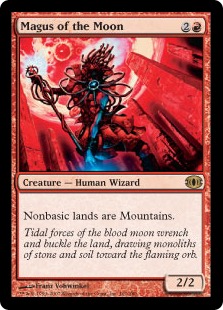 Teeg keeps them from casting planeswalkers.
Teeg keeps them from casting planeswalkers.
Aggro plan (go under):
-4 Mutagenic Growth
-1 Ghor-Clan Rampager
-2 Eidolon of the Great Revel
+1 Gaddock Teeg
+1 Magus of the Moon
+1 Reclamation Sage
+2 Ancient Grudge
+2 Path to Exile
UG Infect: We're slower than this deck, but break up their synergies effectively with Bolt, Tarfire, and more removal from the sideboard. Eidolon can deal a ton of damage, and Tarmogoyf on defense forces Infect to use multiple pump spells to get through. Dryad on defense demands protection spells like Apostle's Blessing to push through non-Agent, non-Inkmoth creatures.
Midrange plan (go over):
-4 Goblin Guide
-4 Monastery Swiftspear
-4 Mutagenic Growth
+1 Huntmaster of the Fells
+1 Magus of the Moon
+1 Reclamation Sage
+1 Spellskite
+4 Path to Exile
+2 Pyroclasm
+2 Ancient Grudge
Burn: It's a good ol' fashioned race, except we've got more creatures, and great ones too. Burn has always struggled against Tarmogoyf, and against Burn decks with Wild Nacatl. Mutagenic Growth adds insult to injury. They can still peel Lava Spikes from the top and kill us, so we can't rely on locking them out of the game. I like Traverse in this matchup since it can grab Tarmogoyf at a moment's notice, or a life-gain creature if we have the mana for it. It also sets up land drops, something supremely important against Burn. The slower Bauble is too much of a liability against opposing Eidolons.
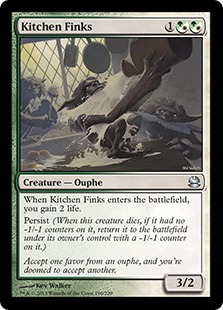 Tempo plan (race):
Tempo plan (race):
-4 Eidolon of the Great Revel
-4 Mishra's Bauble
+1 Spellskite
+1 Gaddock Teeg
+1 Scavenging Ooze
+1 Magus of the Moon
+1 Kitchen Finks
+1 Huntmaster of the Fells
+2 Pyroclasm
Affinity: Affinity has trouble weathering all our removal post-board. Huntmaster carries the game away by himself, but a couple decent threats will do the trick on a Grudged-out opponent.
Midrange plan (go over):
-4 Goblin Guide
-4 Monastery Swiftspear
-4 Mutagenic Growth
+1 Huntmaster of the Fells
+1 Magus of the Moon
+1 Reclamation Sage
+1 Spellskite
+4 Path to Exile
+2 Pyroclasm
+2 Ancient Grudge
Scapeshift: Fairly easy to get under, though Anger of the Gods can be a pain if we're not ready. Playing around the sorcery with boards of Goyf/Guide, or Eidolon/Dryad/Mutagenic, is the key to beating it---we just have to not overcommit our creatures. Scapeshift's midrange elements from the board don't do much to quell our assault, which loses minimal steam as a couple disruptive elements join the mainboard.
Aggro plan (go under):
-1 Ghor-Clan Rampager
-1 Mishra's Bauble
+1 Gaddock Teeg
+1 Magus of the Moon
Gruul Zoo: Gruul has an edge over us in Game 1, but our midrange cards trounce them the rest of the match. Huntmaster and Kitchen Finks stall the deck considerably. Gruul Zoo also struggles to get through 12 removal spells, Goyfs, and a playset of Mutagenic Growth that swings combat in our favor and counters their one removal spell.
Midrange plan (go over):
-4 Goblin Guide
-4 Monastery Swiftspear
-1 Ghor-Clan Rampager
+1 Scavenging Ooze
+1 Kitchen Finks
+1 Huntmaster of the Fells
+4 Path to Exile
+2 Pyroclasm
Neutral Matchups
Abzan Company: The cards Collected Company and Kitchen Finks can really hassle us, especially when one finds the other. Guide, Swiftspear, and Eidolon all underperform in Game 1. Post-board, we are slightly favored thanks to Pyroclasm and four Paths. Magus also randomly wrecks CoCo by turning off colored or utility lands. Gaddock Teeg keeps Chord and Company from hitting the stack, but given enough time, Abzan Company will out-grind us. We need to clean up the game with Tarmogoyf and friends before they reach the late-game, by which time they'll have made enough land drops to recover from our early creature removal.
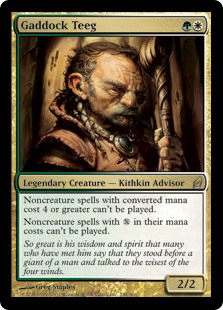 Tempo plan (race):
Tempo plan (race):
-4 Goblin Guide
-4 Monastery Swiftspear
-4 Mutagenic Growth
+1 Gaddock Teeg
+1 Scavenging Ooze
+1 Spellskite
+1 Magus of the Moon
+1 Kitchen Finks
+1 Huntmaster of the Fells
+4 Path to Exile
+2 Pyroclasm
Merfolk: A decent matchup if we draw enough removal spells, but Merfolk can outpressure us on the board with a runaway Vial. Spreading Seas is particularly strong against us, since it makes our lands into colorless sources that exclusively cast Tarmogoyf. If we open few lands and Merfolk opens Seas, it becomes very difficult to win. We need to aggressively Traverse into Mountain in that scenario, which is less than ideal, since Merfolk cantrips off its Seas. We get a lot better post-board with Grudge, Path, and Pyroclasm, which put us in the driver's seat for Games 2-3.
Midrange plan (go over):
-4 Monastery Swiftspear
-2 Eidolon of the Great Revel
-4 Mutagenic Growth
+1 Reclamation Sage
+1 Huntmaster of the Fells
+4 Path to Exile
+2 Pyroclasm
+2 Ancient Grudge
Unfavorable Matchups
Bolt-reliant midrange decks are our most challenging matchups. Against Jund, a tempo plan proves difficult given the deck's extremely low curve and efficient interaction. Their Bolt/Inquisition/Goyf suite gouges substantial holes in our strategy and punishes us for taking mulligans. 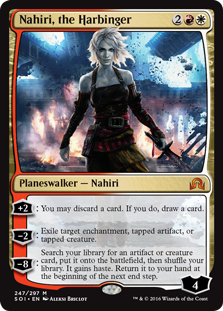 Our only answer to Goyf in Game 1 is Goyf + Mutagenic, or a lucky Ghor-Clan attack. We're basically a Burn deck that gives up Lava Spikes for always-sticking Vexing Devils; against Jund, that means handing our opponent more opportunities to trade with us one-for-one.
Our only answer to Goyf in Game 1 is Goyf + Mutagenic, or a lucky Ghor-Clan attack. We're basically a Burn deck that gives up Lava Spikes for always-sticking Vexing Devils; against Jund, that means handing our opponent more opportunities to trade with us one-for-one.
Jeskai is even tougher to beat. Lightning Helix, Timely Reinforcements, and Anger of the Gods trivialize our quick starts, and Nahiri looks as good against us as it will against anybody.
I won't post sideboard plans for these two matchups because I haven't yet found something that works. It's possible I need more practice, and it's possible I simply haven't discovered the tools yet that will allow me to win them. These may also just be terrible matchups for Delirium Zoo, no matter what I do. In any case, I'm open to suggestions!
Every Time We Deathtouch
There's plenty to love in Eldritch Moon besides [tippy title="Gnarlwood Dryad" width="330" height="330"]
 [/tippy], and I may well be onto some other concoction by next week. But I've been playing around with Eidolon/Mutagenic Growth decks in Modern for about a year, and don't plan on ever benching them permanently. After all, I still have BUG Faeries sleeved up. Gnarlwood seems like a solid include in this kind of deck, and I'm always ecstatic when Wizards throws a bone to one of my pet side projects. Is EMN tickling everyone else the same way? Let me know in the comments.
[/tippy], and I may well be onto some other concoction by next week. But I've been playing around with Eidolon/Mutagenic Growth decks in Modern for about a year, and don't plan on ever benching them permanently. After all, I still have BUG Faeries sleeved up. Gnarlwood seems like a solid include in this kind of deck, and I'm always ecstatic when Wizards throws a bone to one of my pet side projects. Is EMN tickling everyone else the same way? Let me know in the comments.




This is a great article Jordan, as most of your brewing and analysis pieces are. From one brewer to another, it’s rewarding to follow your articles, as we seem to have been on similar new idea trains over the past few years. I’m currently working in Sultai with the new pieces we’ve been given–I’d love to see your take on the interactions between Delve and Emerge and/or Delirium. I’m as yet non convinced that the true dream can occur and make a deck that features all three, but Delirium has received excellent enablers and rewards in EMN, and Delve/Emerge synergize too beautifully not to work with. A turn 3-4 Decimator of the Provinces or Distended Mindbender as a follow up to a Delve threat seems very powerful.
Thanks! Since Eldritch Evolution was spoiled, I’ve also been brewing with delve creatures. Right now I feel a Temur shell is best, since it interacts so efficiently with the field (using Bolt, Pyroclasm, Moon, etc.). I tried fitting Traverse into the shell, but it clashes with the delve creatures too much. I don’t love combining Evolve with emerge yet. We just haven’t seen enough good emerge cards to warrant it, and we have plenty of great creatures to go into with a humble Hooting Mandrills (Sundering Titan, Griselbrand).
When I first saw Eldritch Evolution, I thought, “Hey, cool, that could be fun.”
Then I thought of actual scenarios, and got pretty excited.
Then I saw one or two other folks’ scenarios, and got even more excited.
Then I saw even more scenarios, and started to get worried. I mean, T1 mana dork, T2 Allosaurus Rider –> Evolution –> Any 9-drop of your choice? Remember, they can’t even Bolt the Rider prior to you casting EldEvolution, as long as you don’t try to do something else in between.
Kinda has me worried.
I’m not super nervous about a T2 combo that requires Evolution, Rider, a dork/Sprawl in play, two extra green cards to pitch, and two lands to go on curve. That’s an incredibly specific series of draws; Griselbrand strategies are significantly more consistent and those decks aren’t even Tier 3 currently.
Evolution is almost definitely playable, but this particular combo doesn’t have me worried. It just seems like another powerful Modern strategy along with all the rest. It turns out if you take any existing Tier 1 strategy, remove it from the format, and then reintroduce it again, we can easily make a rhetorical case for how ridiculously broken that deck is. And yet, all those decks coexist pretty nicely.
The only part about that scenario that’s “incredibly specific” is having EldEv and Rider in the opener together. The dork is optional (doing this on 3 is still strong), and the rest is just “have cards of your deck’s main color somewhere in your first 7-9 cards of the game” and “not be mana screwed”. All you need for this scenario is a generically keepable hand that has two specific cards in it. There would also be games where you kept a “normal” hand with a plan for a “normal” use of EldEv, then topdeck Rider in any of your first few draw steps, and go “Oops, free haymaker!”
Compare to Amulet Bloom: it needed Amulet of Vigor and Summer Bloom, just like the above needs Rider and EldEv. So far, they’re even. Then where the above needs “three mana sources”, Bloom needed specific types of lands that only made up a portion of the manabase. Advantage: EldEv/Rider. Where the above needs “green cards in a green deck”, Bloom needed to specifically have one of their win conditions. Advantage: EldEv/Rider (again).
I could be wrong, but it looks to me like the Rider/EldEv combo is actually *less* specific than one that was deemed too powerful. And that’s just the combo: there’s still delve fatties and so forth, so it’s not like such a deck would crumble if it doesn’t find the combo.
Granted, I’m just some internet noob, so maybe I’m way off base. But it doesn’t look like a Magical Christmas Land scenario to me.
Agreed. The Allosaurus variants I’ve been trying have been a lot less consistent than goodstuff midrange piles that splash an Evolution package to abuse with delve.
Gnarlwood dryad seems like a pretty sweet card. What do you think of it in a deck like Patrick Chapin’s temur prowess:
http://www.starcitygames.com/article/31555_Showing-Off-Your-Prowess-In-Modern.html
I actually tried it in this shell and came to the same conclusion as before Gnarlwood was spoiled: it’s either a worse Zoo or a worse Monkey Grow. I don’t think this kind of prowess deck is focused enough to make it in Modern.
Great article, thanks! Re: beating Jund/Jeskai: they’ll be hard matchups for sure. I would guess the matchup is slightly better than “normal” Zoo (eg, with Bushwhacker) because of your ability to outgrind weaker hands, but I’m not sure. You could try a Mark of Asylum in the sb, but that’s not really exciting. (Note: One Reckless Bushwhacker to tutor for could be sweet, maybe even main).
Could Gnarlwood Dryad be an upgrade to the Steppe Lynx/Kird Ape slot in Death’s Shadow Zoo? May be worth adding Bauble and/or Tarfire to support it, but maybe not.
Very possible. I have never liked Steppe Lynx in that deck, which I think is too easy to disrupt with a few Bolts at the right time. I’ve found they usually draw Lynx at the wrong time when faced with disruption. Dryad makes the deck much more consistent, as they’re already in Bauble/Probe/Wraith/fetchland.
I knew that little guy would find a home
Great article, I really like how you squeeze as much out of delirium as you can. Transverse is a card just waiting to be exploited IMO. Maybe have something in the board besides rec sage to deal with your RIPs and leylines just in case. I dunno, maybe the nacatl/eidolon/swiftspear beatdown plan is enough to just allow them to play graveyard games while you chip away life total.
On another note, would you call evolution playable when remand exists and chord is an option? The only time I see evolution winning out is if you are sacking a big creature to it to get something like a craterhoof. I could see something going on with the primordial command decks that play sprawl. I like the similarity to pod, but I think part of what made that card good was that it was a permanent, not a one and done card.
I think whispers of emrakul, dryad, escalate cards, and hanweir battlements have the best chance of making an impact on modern.
Destructive Revlery is a SB option, but for now my plan against RIP effects is, as you said, to ignore it with one-drops.
Evolution is definitely playable and should at least find a home in certain builds of Chord-style toolbox decks. I can see it making waves in Kiki-Chord, for example, since they can sacrifice Finks to go into either Angel or Kiki-Jiki.
Players only have so many Remands, not to mention the card is terrible against the format’s big aggro three (Infect, Affinity, Burn). A rise in Remand strategies could allow those decks to claw back some metagame shares from Bolt-based midrange and Hierarch decks.
Hey Jordan, nice article. The Delirium aspect of your deck got me to thinking what other aggressive shells would want cards like Mishra’s Bauble, and I think that Suicide Zoo would be a potentially strong fit for the Gnarlwood Dryad (and I could even see a couple of tech pieces from your deck, like Tarfire, making their way into it). I think it could potentially alleviate some of the manabase stretching issues that Nacatl imposes (i.e. a deck that really doesn’t run any white cards needing white shocks to ensure Nacatl remains a 3/3), and could add another tool to the deck’s toolbox (a deathtouching blocker can be pretty good on the occasions Suicide Zoo is forced to block for a bit). What say you?
Yep, as stated above, I think Gnarlwood will be great in that deck. Bauble, Wraith, and Probe make delirium trivially easy to hit there. They’ll probably keep Nacatl and just cut Lynx, though.
I think people should buy their Baubles now if they want them and don’t have them. And not just because of Gnarlwood and Traverse—Grim Flayer is super, duper good.
Prior to the EMN spoilers I was looking at Bushwhacker/Emissary/Tarmogoyf Zoo, and thinking of ways to spike the deck to grow the Goyf. I also identified Eidolon of the Great Revel, and Tarfire. Since I did not own Mishra’s Bauble, and, due to the cost, was not planning to purchase them, I thought about decent sorceries. The one that has worked best is Rift Bolt. My version of the deck is Burn heavy, playing 3 Rift Bolt, 3 Tarfire, 4 Lightning Bolt, 3 Atarka’s Command, as well as 3 Eidolon of the Great Revel, so it’s looking to do a lot of indirect damage. I haven’t got the deck quite balanced, so I’m playing more than 60 cards to fit in all the creatures, 3 Path to Exile, and land. I think that the Gnarlwood Dryads might replace the Bushwhacker/Emissary, because getting only one of the pair is far less valuable. The take-home message is that Rift Bolt is worth a look in a Goyf/Delirium set-up.
BUG Faeries, huh? Have you updated that list at all?